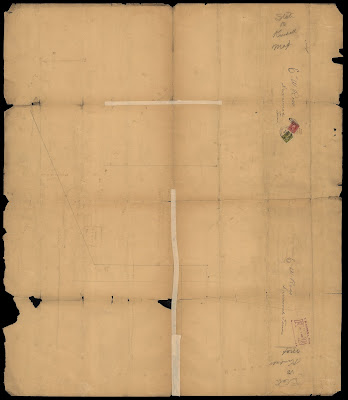The Tennessee Supreme Court Records Project is one of the largest projects at the Tennessee State Library and Archives. We currently house more than 10,000 boxes of our state’s judicial history dating from before statehood to 1950. In processing these records, we have come across a wide variety of cases covering everything from debt disputes to murder. Occasionally, we will find a case that draws on several aspects of our state's history like the one described in this blog post. This record is an interesting example of race relations in the 20th Century in a small West Tennessee county.
The case file is titled State of Tennessee v. Lennie Kendall and it took place in Savannah, in Hardin County, in 1916. Lennie Kendall was an African American who was charged with the murder of James (Jim) Young, a Caucasian man. The case was first heard in the Circuit Court of Hardin County before a change of venue to Henderson County. The case eventually ended up in the Supreme Court of Tennessee in April of 1917.
 |
| Tennessee Supreme Court Case File: State of Tennessee vs. Lennie Kendall |
Lennie Kendall, then age 22, worked on a steamboat and Jim Young, then 21, worked at his father’s store in Savannah. These two young men had known each other their whole lives and had both grown up in Savannah. It was apparently known around town that Young had been associating with an African-American girl named Bertha Williams. Kendall had also been interested in Williams in months prior, but had stopped talking to her because of Young’s objections.
On the evening of June 17th, 1916, both men attended a house party in the African-American section of town known as “Stringtown.” An interesting part of this case was that it included a hand-drawn map by the defendant’s lawyer, E. W. Ross, of Stringtown. The map shows a school, church, and residents' houses. During his cross examination, Sheriff J. W. Tackett describes Stringtown as “strictly a negro settlement, only one white man lived anywhere in that neighborhood…”
 |
| The map was drawn by E. W. Ross, Kendall’s defense lawyer, and was identified as Exhibit “A” during the trial. It shows the African American section of Savannah, known as "Stringtown." |
 |
| Another view of the hand-drawn map by E. W. Ross, Kendall’s defense lawyer, identifying the African American section of Savannah as "Stringtown." |
It was noted in the brief that Kendall, Williams, and another unnamed African-American woman attended the party together. A witness claims that Young showed up later that evening and was seen talking to Williams. As the evening progressed, Young and Kendall were seen outside in the yard when Young reportedly pulled a pistol on Kendall and made several threats. Kendall then returned home, got his single barrel shot gun, and returned to the party where the two men spoke again. Shots were fired by both men and Young was killed. Kendall was shot in the foot.
After the death of Young, Kendall fled town for fear of his life. Sheriff Tackett testified that as a result of an African American killing a white man “150-200 men gathered with guns, pistols and ropes in search of the defendant and that if he had been found he would have been mobbed, and that that condition existed at the time of his arrest at Selmer in McNairy.” After his capture, Kendall was charged with the murder of Jim Young. However, there was concern about where to have the trial.
Due to concerns about potential mob violence, Kendall's attorney asked for a change of venue, a request that the attorney general supported. The transcript stated that “on behalf of the defendant, and after hearing the evidence of many witnesses, it was made to satisfactory appear to the Court that from undue excitement against the defendant in Hardin County, where the offense with which he was charged was committed a fair trial could not probably be had, it being made to appear to the Court that the Sheriff deemed it unsafe to bring the defendant to this County…”
The trial was moved to Henderson County, where Kendall was tried and convicted of voluntary manslaughter in October 1916. Kendall appealed the decision, but it was ultimately upheld by the Supreme Court, and he was sent to the penitentiary to serve a term of two to 10 years.
The Tennessee Supreme Court Records Project holds many more fascinating cases just like this one. These records can be a valuable tool for understanding our state’s rich history.
The State Library and Archives is a division of the Tennessee Department of State and Tre Hargett, Secretary of State
